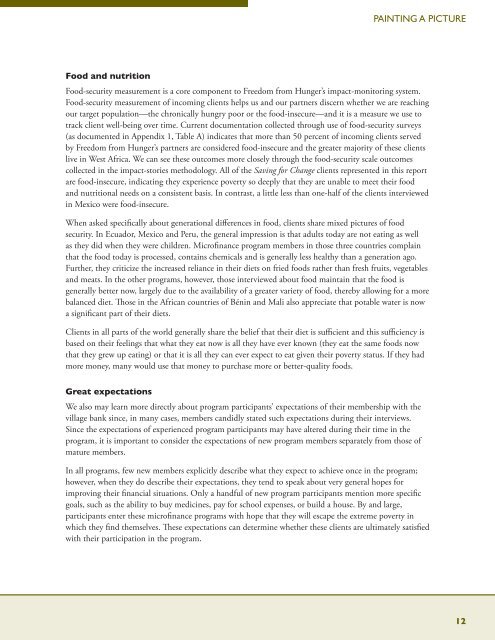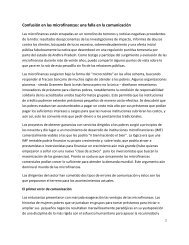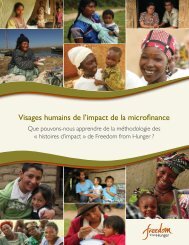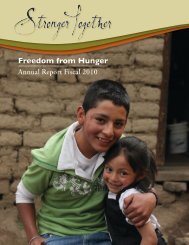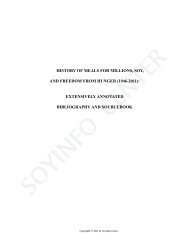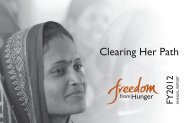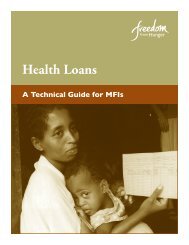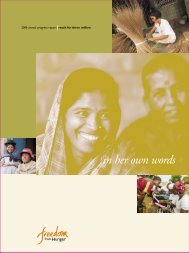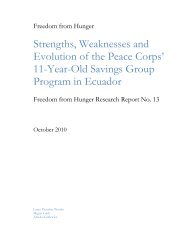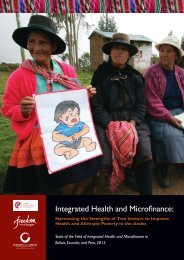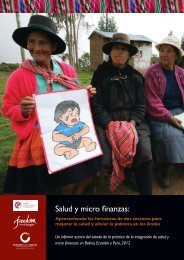English - Freedom from Hunger
English - Freedom from Hunger
English - Freedom from Hunger
You also want an ePaper? Increase the reach of your titles
YUMPU automatically turns print PDFs into web optimized ePapers that Google loves.
PaInTIng a PICTuRe<br />
Food and nutrition<br />
Food-security measurement is a core component to <strong>Freedom</strong> <strong>from</strong> <strong>Hunger</strong>’s impact-monitoring system.<br />
Food-security measurement of incoming clients helps us and our partners discern whether we are reaching<br />
our target population—the chronically hungry poor or the food-insecure—and it is a measure we use to<br />
track client well-being over time. Current documentation collected through use of food-security surveys<br />
(as documented in Appendix 1, Table A) indicates that more than 50 percent of incoming clients served<br />
by <strong>Freedom</strong> <strong>from</strong> <strong>Hunger</strong>’s partners are considered food-insecure and the greater majority of these clients<br />
live in West Africa. We can see these outcomes more closely through the food-security scale outcomes<br />
collected in the impact-stories methodology. All of the Saving for Change clients represented in this report<br />
are food-insecure, indicating they experience poverty so deeply that they are unable to meet their food<br />
and nutritional needs on a consistent basis. In contrast, a little less than one-half of the clients interviewed<br />
in Mexico were food-insecure.<br />
When asked specifically about generational differences in food, clients share mixed pictures of food<br />
security. In Ecuador, Mexico and Peru, the general impression is that adults today are not eating as well<br />
as they did when they were children. Microfinance program members in those three countries complain<br />
that the food today is processed, contains chemicals and is generally less healthy than a generation ago.<br />
Further, they criticize the increased reliance in their diets on fried foods rather than fresh fruits, vegetables<br />
and meats. In the other programs, however, those interviewed about food maintain that the food is<br />
generally better now, largely due to the availability of a greater variety of food, thereby allowing for a more<br />
balanced diet. Those in the African countries of Bénin and Mali also appreciate that potable water is now<br />
a significant part of their diets.<br />
Clients in all parts of the world generally share the belief that their diet is sufficient and this sufficiency is<br />
based on their feelings that what they eat now is all they have ever known (they eat the same foods now<br />
that they grew up eating) or that it is all they can ever expect to eat given their poverty status. If they had<br />
more money, many would use that money to purchase more or better-quality foods.<br />
Great expectations<br />
We also may learn more directly about program participants’ expectations of their membership with the<br />
village bank since, in many cases, members candidly stated such expectations during their interviews.<br />
Since the expectations of experienced program participants may have altered during their time in the<br />
program, it is important to consider the expectations of new program members separately <strong>from</strong> those of<br />
mature members.<br />
In all programs, few new members explicitly describe what they expect to achieve once in the program;<br />
however, when they do describe their expectations, they tend to speak about very general hopes for<br />
improving their financial situations. Only a handful of new program participants mention more specific<br />
goals, such as the ability to buy medicines, pay for school expenses, or build a house. By and large,<br />
participants enter these microfinance programs with hope that they will escape the extreme poverty in<br />
which they find themselves. These expectations can determine whether these clients are ultimately satisfied<br />
with their participation in the program.<br />
12


